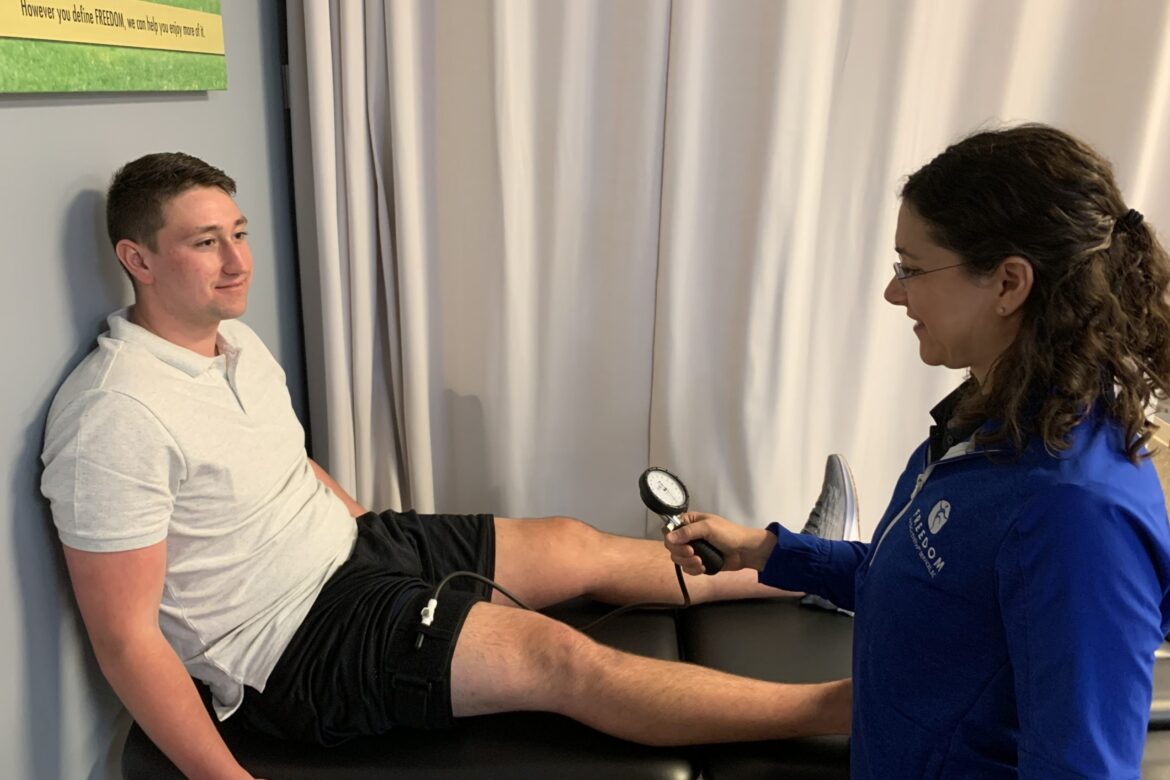Is BFR Just a Fad?
Certain exercise ideologies tend to come and go, but I do not believe that BFR is one of those trends or fads. I have recently had a handful of patients that have heard about BFR (Blood Flow Restriction Training) from podcasts, online health journals, and other media outlets. This has led to questions about how it works and how it can be used outside of therapy. This blog will help explain, what is blood flow restriction training better.
What is Blood Flow Restriction Training?
Blood Flow Restriction Training is when a strap, band, or tourniquet is used to reduce blood flow to an arm or leg either with activity or at rest. The tourniquet reduces blood flow to the limb it is being used on and therefore reduces oxygen transfer to those structures. Our muscles and other structures require oxygen as their main energy source. When we remove some of that energy source, we force the body to use different energy sources it would only use during those high intensities or high load exercises.
How BFR Works
My favorite real-life example to help people understand how it works is comparing going for a one-mile walk in Milwaukee, Wisconsin to a one-mile walk in Denver, Colorado. In Denver, the oxygenation is lower due to the elevation of the city. This oxygen difference makes the activity of walking one mile more challenging in Denver than it would be to walk one mile in Milwaukee. When we use BFR, we are trying to put your body in Denver. We give you an activity that you can normally do without difficulty and then we restrict oxygen to the targeted part of the body.
When we remove oxygen to a part of the body during activity, it gets harder, makes you breathless, and gives you that deep burning sensation in the limb(s). It feels like you are heavily training without having to impart that significant load on your body. Those things you feel happening in your body force the body to think you are doing high-intensity exercise without doing high-intensity exercises. That means when you are done working out, your body has less inflammation and healing to take care of. It can focus its energy on muscle hypertrophy which is just a fancy word for making your muscles bigger. Bigger muscles mean stronger muscles which make for a happier body.
Benefits of Blood Flow Restriction Training
One of the biggest therapeutic benefits and uses of BFR training is that it allows us to add a significant challenge to a muscle without using heavy external resistance. This reduces the risk of putting stress on an injured joint that isn’t ready to be trained in that way. It also simultaneously performs maintenance exercises to prevent atrophy (muscle loss) from occurring from disuse after injuries.
A perfect example is using BFR cuffs with a teenager that has sustained an overuse back injury when returning to rowing season on the water. If they are having trouble rowing against resistance or performing any lifts with weight, we can use BFR. We can use BFR cuffs during dry land training lifting activities like squats, deadlifts, and or hang cleans with a significantly reduced weight. This will still challenge the musculoskeletal and cardiovascular systems to allow them to maintain or continue to progress their training so they don’t miss a beat when they can return to full practice.
Who Benefits from BFR Training?
One of the largest misconceptions I have encountered in my practice is the thought that BFR training is solely for high-level athletes or teens/young adults. It can be used with any population, as long as you do not have any contraindications. We can use BFR to improve everyday activities such as someone having trouble performing stairs due to arthritic knee pain. Utilizing BFR with leg strengthening exercises in a non-weight-bearing position (lying on a table) will significantly challenge the important muscles of the leg with very little resistance. There will be very little aggravation to the arthritic joint involved. The faster we can achieve muscle growth with minimal pain in the problematic joint, the easier it will be for the person to perform their daily functional tasks with less pain.
BFR is a beneficial tool to supplement a bout of physical therapy, but also for continued use to maintain joint health while still performing strength training. This is something I, myself, incorporate into my training at least once a week. Due to many years of training as a competitive figure skater in my younger years, my knees and hips took a lot of stress during that time, and now I have limited tolerance for repetitive weight-bearing activities including running, and squatting with weight, etc.
BFR has been a great supplement to my weekly activities allowing me to get my heart rate up which keeps my heart healthy and feel muscularly tired at the end of a workout without having a lot of knee or hip joint pain. If you have any questions about using this as an additional tool for your rehab or joint healthy workouts, contact one of our certified BFR therapists at Freedom Physical Therapy Services.

